Even after you have determined that you have a good wind resource and a viable site, putting a down payment on a turbine is a huge commitment. How do you choose the right wind turbine from a reliable manufacturer? The turbine that you choose for your project will depend on your wind resource, the goals of your project, and the price and availability of turbines (many turbines have long waiting lists), as well as the reliability of the machine and availability of spare parts and expertise to fix the machine if it breaks. This section is intended to give you some idea of what to look for when choosing a turbine and to provide you with information on turbine manufacturers and turbine specifications.
- Turbine Basics
- Choosing a Turbine
- Negotiating a Turbine Deal
- Commercial-Scale Turbine Manufactures
- Additional Resources
Turbine Basics
Types of Wind Turbines
Almost all wind turbines in use today are horizontal axis with three blades rotating upwind of the tower. Vertical axis designs represented approximately 5 percent of the market in the late 1990’s, but have been phased out due to various problems such as blade fatigue, difficulty with mounting on high towers to capture the best wind, and other design issues.
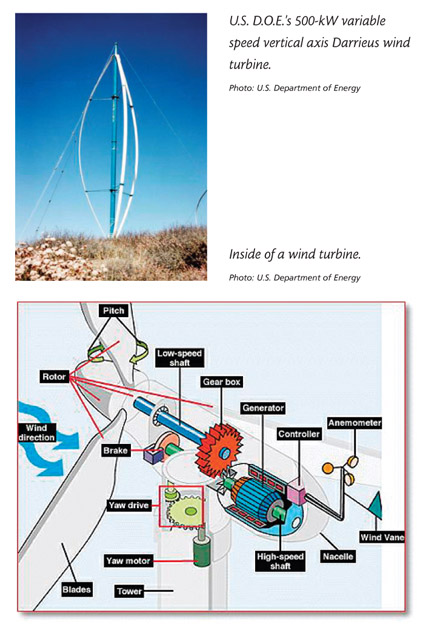 Wind turbines come in many different sizes for different applications. The nameplate capacity rating refers to a turbine’s peak energy output. Turbines in use today range from less than 1 kW to 3 MW or more in nameplate capacity. Many wind turbine manufacturers are rapidly developing even larger machines, especially for offshore applications.
Wind turbines come in many different sizes for different applications. The nameplate capacity rating refers to a turbine’s peak energy output. Turbines in use today range from less than 1 kW to 3 MW or more in nameplate capacity. Many wind turbine manufacturers are rapidly developing even larger machines, especially for offshore applications.
How Wind Turbines Work
Most large wind turbines are induction generators. They are similar to many motors that are used in industrial processes (many blowers, elevators, pumps and other devices use this design). The generators are essentially motors that are run in reverse, generating power instead of consuming it. When enough torque (force from the wind) is applied to the blades of the machine to create a high enough speed, the turbine connects to the grid and begins to produce energy. The frequency of the grid in the United States is 60 Hz. That means that the generator itself is running at a slightly faster speed than 3600 revolutions per minute (although it may run at 1800 or 1200 rpm depending on the electrical wiring of the machine). The blades rotate at approximately 15 to 25 RPM (for a 1.5 to 2.0 MW turbine), and a gear box increases the RPM to that of the generator. This is the predominant design for wind generators because it is very simple and based on a motor and generator design that has been around for many years.
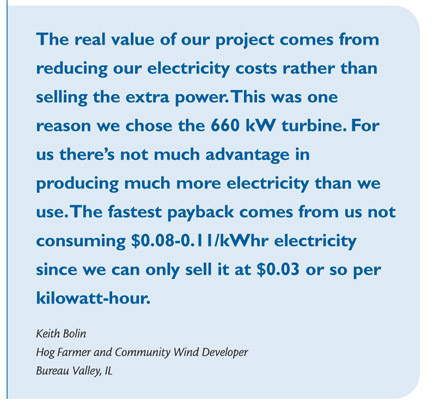 The other type of wind generator is one that operates similar to a direct current (DC) machine, or uses an alternator to produce energy. The generator can vary its speed based on existing wind and grid conditions to produce energy. The energy is then conditioned for the grid using power electronics and computer control systems. These machines can be made to be more efficient than the induction type, but can carry added cost from the power electronic systems.
The other type of wind generator is one that operates similar to a direct current (DC) machine, or uses an alternator to produce energy. The generator can vary its speed based on existing wind and grid conditions to produce energy. The energy is then conditioned for the grid using power electronics and computer control systems. These machines can be made to be more efficient than the induction type, but can carry added cost from the power electronic systems.
Most modern machines, regardless of type, now have power electronics and computer control systems to optimize their energy capture from the wind. The computers and control systems can change the pitch of the blades for braking and added energy capture, control current and voltage wave forms to help improve power quality on the grid, and sense conditions of the grid to provide reactive power support. They are highly sophisticated machines that have evolved from numerous preceding generations of wind turbine technology.
Choosing a Turbine
The turbine you decide to purchase must fit your needs for size, wind resource, availability, reliability, warranty, spare parts availability, and proximity of operation and maintenance teams.
Size
In general, wind projects are modular energy facilities and can consist of one to one hundred turbines or more. The overall size of a wind project is a function of many variables, including the amount of land available, the number of investors and size of each investor’s contribution, the financing available to the project, the ability of the transmission or distribution grid to handle the additional energy from the project without substantial system upgrades, and the number of turbines available to the project. Often one or several of these factors combined will determine the size of the project.
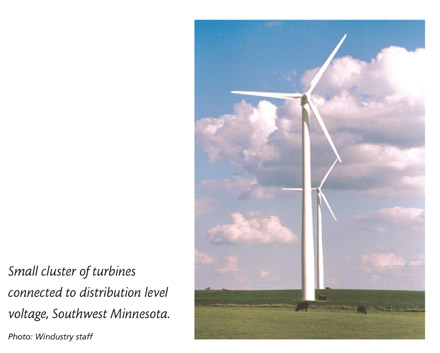 For instance, a project might be developed initially at 10 MW. After going through part of the interconnection process, you may find out that a project larger than 8 MW will cause the project to incur significant interconnection costs. In this case, it might be prudent to only develop an 8 MW project. In other instances, there might be significant interconnection costs regardless of the size of the project. In these cases, it may be advantageous to construct a much larger project to help spread out the interconnection and other associated costs over as many turbines as possible. The key factor here is economics. The size and number of turbines should be based on obtaining the best possible return while taking into account constraining factors.
For instance, a project might be developed initially at 10 MW. After going through part of the interconnection process, you may find out that a project larger than 8 MW will cause the project to incur significant interconnection costs. In this case, it might be prudent to only develop an 8 MW project. In other instances, there might be significant interconnection costs regardless of the size of the project. In these cases, it may be advantageous to construct a much larger project to help spread out the interconnection and other associated costs over as many turbines as possible. The key factor here is economics. The size and number of turbines should be based on obtaining the best possible return while taking into account constraining factors.
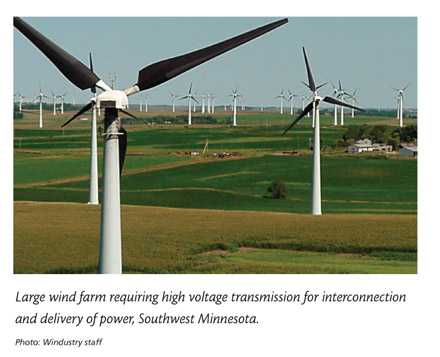 The size of the turbine model to be used at a project will be based on available models, the wind resource at a site, and the ability to perform maintenance. Larger machines on taller towers can cause added expense and delays in replacing major components because there are relatively few cranes that have the ability to lift heavy loads to the top of tall towers. Smaller turbine models may make maintenance easier, but could provide lower production revenue because of a shorter tower or a less efficient machine.
The size of the turbine model to be used at a project will be based on available models, the wind resource at a site, and the ability to perform maintenance. Larger machines on taller towers can cause added expense and delays in replacing major components because there are relatively few cranes that have the ability to lift heavy loads to the top of tall towers. Smaller turbine models may make maintenance easier, but could provide lower production revenue because of a shorter tower or a less efficient machine.
![]()
![]() Keep in mind that determination of project size and turbine size should be based on the options that will provide the best economic return for investors and the practicality of acquiring equipment and maintaining it.
Keep in mind that determination of project size and turbine size should be based on the options that will provide the best economic return for investors and the practicality of acquiring equipment and maintaining it.
Wind Resource and Climate
Wind turbines are designed for specific wind resource and environmental criteria, summarized by four International Electrotechnical Commission (IEC) classes (I-IV). IEC class I is the highest wind and turbulence criteria and class IV describes the lowest wind speeds and turbulence criteria. In general, turbines designed for high energy capture in low wind regimes will have larger rotors. On the other hand, turbines designed for high wind regions tend to have larger nameplate generator ratings and smaller rotors. You might need to obtain gust data in order to determine which turbine is right for your site. Consider a wind turbine model with a good track record in areas with a wind resource and climate similar to those at your site.
Availability for Purchase
The turbine you select must not only fit your project and site requirements, it also must be available for purchase within your time frame. Many large wind turbine manufacturers are based in Europe, making transportation and timing important considerations. Also, it is more cost effective for manufacturers to serve customers seeking large numbers of turbines, which can make it difficult for the customer looking for a single turbine or small numbers of turbines.
Used Wind Turbines
![]() Used wind turbines are showing up more frequently on the market. It is advisable to approach the purchase of used wind turbines with caution. They may be less expensive upfront but may be fraught with operational problems. Lenders may not be willing to finance used equipment because of the perceived higher risk. In general, if you are considering purchasing used you need to make sure that you understand:
Used wind turbines are showing up more frequently on the market. It is advisable to approach the purchase of used wind turbines with caution. They may be less expensive upfront but may be fraught with operational problems. Lenders may not be willing to finance used equipment because of the perceived higher risk. In general, if you are considering purchasing used you need to make sure that you understand:
- The operational history of the machine;
- Why it was taken out of commission;
- What has been done to bring the machine back to operational status;
- If the machine comes with a warranty;
- What the availability of spare parts is; and
- What is the availability of skilled labor to fix the machine.
You need to consider these issues as well as all of the other turbine issues if you go down this path. A clear awareness of the risks associated with used equipment should be central in the consideration of your project.
Reliability
![]() Turbines that are not producing energy are losing money, and a machine that breaks down regularly will quickly eat away at your bottom line. Consider that most projects are designed to be operational 98 percent of the time (“98% availability”). This only allows approximately 7 days per year that each turbine can be shut down for regular and non-scheduled maintenance.
Turbines that are not producing energy are losing money, and a machine that breaks down regularly will quickly eat away at your bottom line. Consider that most projects are designed to be operational 98 percent of the time (“98% availability”). This only allows approximately 7 days per year that each turbine can be shut down for regular and non-scheduled maintenance.
Picking a machine that has a good track record in the field as well as a manufacturer with a reputation for quality equipment and quick response when problems do arise will help to keep your project in the black. Talk to as many different developers, maintenance company representatives, people who are investors in projects, consultants, and others in the industry as you can to learn who is selling the best machines and which models to avoid. If you have to wait a little longer for a quality machine and can build this into your project timeline, it may be a worthwhile consideration.
Warranty
Most wind turbine manufacturers offer a standard 2-year parts and labor warranty, which may include a power curve and availability warranty. It is also common for turbine manufacturers to offer to extend the warranty to 5 years at an additional cost. These warranties will address design and manufacturing flaws and provide replacement parts and labor. Extending the warranty on the machines for smaller projects is generally a good idea, and financing institutions may require this before lending money to the project. An extended warranty will provide insurance against major failure while the project accrues a contingency fund for any major equipment failures after the warranty period expires.
![]() A contingency fund is money that is set aside in a separate reserve account for the project to access after the warranty has expired to pay for major repairs or component replacement above and beyond scheduled maintenance, and is an important item to include in the business plan for your project.
A contingency fund is money that is set aside in a separate reserve account for the project to access after the warranty has expired to pay for major repairs or component replacement above and beyond scheduled maintenance, and is an important item to include in the business plan for your project.
The turbine sales agreement will cover delivery schedule of the machine (important due to tight construction and interconnection schedules), parts, and labor. It may also cover the power curve, ensuring that the machine will generate as much electricity (and revenue) as you had planned for in your business prospectus, although the technical requirements for measuring the power curve can prove very expensive and are not generally affordable for smaller projects.
Proximity of Operation and Maintenance Teams
Your operations and maintenance costs will be significantly reduced if your turbine supplier or other qualified vendor has active O&M teams in your area. This reduces the cost of travel and reduced availability resulting from unscheduled maintenance requirements.
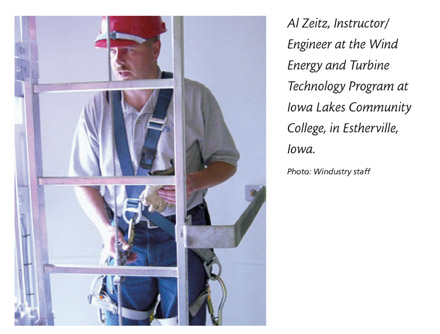 Service Contracts
Service Contracts
Service contracts are available through the major turbine manufacturers and numerous qualified third party vendors. The terms and costs of these contracts will vary with the size and proximity of your project in relation to existing projects using the same manufacturers. Some turbine manufacturers will not offer service contracts if your project is small and/or far away from existing projects or may offer inflated costs to deter you from entering into a contract. Third party O&M companies may be retained for service on machines, but may void the manufacturer’s warranty if they are not approved by the manufacturer.
Negotiating a Turbine Deal
The process of acquiring turbines is more complicated for smaller projects because turbine manufacturers prefer to deal with firms that can commit to large volume orders for several years. Most community developers are smaller and do not have the resources to construct sizeable projects every year. The three P’s that will help you get those turbines in the ground are planning, patience, and persistence.
Planning. Turbine manufacturers generally require a 10-25% down payment for machines well in advance (1-2 years or more) of when the turbines are to be delivered. It goes without saying that you should have a plan for financing your wind project prior to entering discussions with any wind turbine manufacturer. You need to plan for this well in advance, so that you can initiate discussions with turbine manufacturers early on in the development process, and have funds readily available for all turbine payments when required. This will allow you to better position your project in the turbine acquisition queue so that you can get a machine delivered in the time frame your project needs to be successful.
Patience. Negotiation of a turbine purchase can be time consuming and may be complicated by ever-changing market, financial, and policy conditions which are beyond your control. Equipment prices, the global supply of turbine components, raw materials, and transportation costs and schedules all affect your project’s bottom line. These factors can change on a daily basis. Public policy decisions determine the incentives available to your project. Acquiring a turbine purchase agreement that will keep your project in the black requires patience to cope with all these changing factors and rapid growth of the industry.
Persistence. Turbine manufacturers in today’s market are interested in high volume transactions and repeat business to keep overhead costs low and certainty in future orders high. As a new developer with little or no history in the wind industry, you may have to approach many different manufacturers and continually contact them to keep your project moving forward. There are also equity investment firms that have access to particular turbines in exchange for a financial stake in the project. This may make the turbine acquisition process easier but may also dilute the project in terms of financial return and governance, so the positives and negatives of these types of arrangements should be weighed carefully.
Purchasing Strategies for Community Projects
Aggregation. Community wind developers in the Midwest are well aware of the difficulties in negotiating turbine purchase deals. Many community developers are exploring the prospects of negotiating turbine purchase agreements for several projects at the same time, thus reducing transaction overhead costs, and increasing the ability of the community wind developers to garner manufacturers' attention with higher volume orders."
![]() When deciding to work with these firms, you may have to give up some or most of your control of the project or take on additional risk. It is up to you, your board of directors, investors and other key project team members to understand the terms and risks involved before deciding to move forward with a turbine deal involving these companies. It is advisable to work with a lawyer to truly understand the terms of these partnerships.
When deciding to work with these firms, you may have to give up some or most of your control of the project or take on additional risk. It is up to you, your board of directors, investors and other key project team members to understand the terms and risks involved before deciding to move forward with a turbine deal involving these companies. It is advisable to work with a lawyer to truly understand the terms of these partnerships.
Getting Started
Most wind turbine manufacturers will require some basic information about your project before sitting down to the negotiating table. Generally, you as a developer will fill out a project information sheet including: project location and size, information about the wind resource in the area (including 50- or 100-year 3-second gust data), turbulence intensity, site layout, and interconnection plan. The manufacturer may also require you to identify various sources of funding for the project to make sure that you are serious and have made significant progress on developing the project. The application form in most cases does not have to be complete, but should provide enough information to show your understanding and ability to develop the project.
Before sitting down at the negotiating table, gather as much information as you can about the current state of the market and other deals that have been negotiated with the company and with other turbine manufacturers. It is also helpful to assemble a team that includes at least legal support, but it is better to also include engineering and accounting support, so that you can respond effectively to any issues that may arise during the negotiation process.
